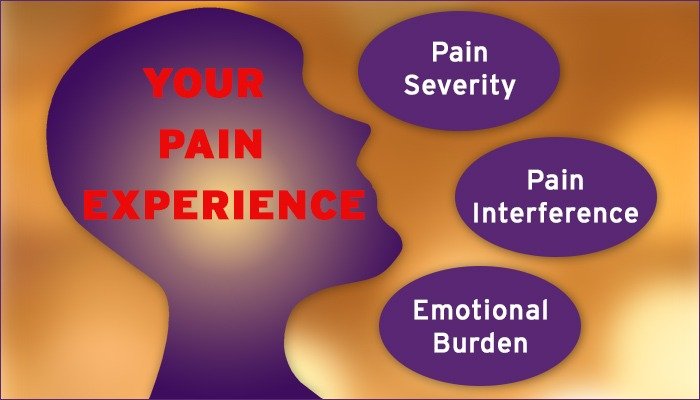Pain Assessment – What is your Profile?

When you think about your own pain experience, you may first think about how much you hurt. But, the full pain experience is actually broader than “how much”. The Initiative on Methods, Measurement, and Pain Assessment in Clinical Trials (IMMPACT) is a group of 27 specialists from academia, governmental agencies, and the pharmaceutical industry. Among other things, this task force identified three core components of chronic pain – the most important features that make up your pain experience. They include:
- Pain Severity
- Pain Interference
- Emotional Burden of Pain
Pain Severity
Pain severity can be measured in a number of ways. You have likely been asked to rate your pain on a 0 to 10 point scale, where 0=”No pain” and 10=”Worst pain imaginable” or “Pain as bad as it could be”. Severity may also be assessed by asking what your average pain level is, your worst, your least. How often and how long you have had your pain problem also contribute to pain severity.
Pain Interference
One of the biggest challenges for pain management is trying to keep on living even though you have pain. Pain may interfere with your work performance (or even your ability to work at all). It may disrupt your relationships, your capacity to do basic activities such as showering or making a meal, participation in recreational activities, work on personal goals, sexual activity, or parenting. The number of areas that are disrupted as well as the degree of interference contribute to your overall feeling of how much pain is getting in the way of living.
Emotional Burden of Pain
Pain is an emotional experience. Your pain may be a trigger for fear, depression, anger, anxiety, and/or loneliness. And negative emotions such as these can feed back into your experience of pain, making pain worse. The emotional part of pain can truly diminish one’s quality of life, even in the absence of severe pain.
The Overall Pain Experience
So, the pain you feel is a combination of all three factors. You may not think about each factor separately, just as you may not think about the sound of each instrument when you are listening to music, each ingredient in a casserole, or each brush stroke in a painting. The pieces make up a unique whole and a unique experience. One reason it is important to look at the three pieces is that your pain problem can be addressed from any or all of these factors. For example, if your pain is highly distressing to you, working on managing your emotions (e.g., through relaxation, exercise, therapy) will have an impact on your overall pain experience, helping you to “feel better” without directly changing the severity of your pain or its interference. Similarly, modifying severity or interference can make a difference too.
What is Your Pain Profile?
Goalistics offers a free pain assessment that examines your severity, interference, and emotional burden. Your answers will be scored and a printable report will be generated showing your scores on each of the three factors. Some people find it helpful to use the report in discussions with their health care provider(s).
————
About the Author. Dr. Linda Ruehlman is a social/health psychologist and researcher, co-founder of Goalistics, and director of the Chronic Pain Management Program, an interactive site that helps people with chronic pain to manage their pain and live richer, more effective lives as well as Think Clearly about Depression, a self-management program for depression.
PainPathways Magazine
PainPathways is the first, only and ultimate pain magazine. First published in spring 2008, PainPathways is the culmination of the vision of Richard L. Rauck, MD, to provide a shared resource for people living with and caring for others in pain. This quarterly resource not only provides in-depth information on current treatments, therapies and research studies but also connects people who live with pain, both personally and professionally.
View All By PainPathways






